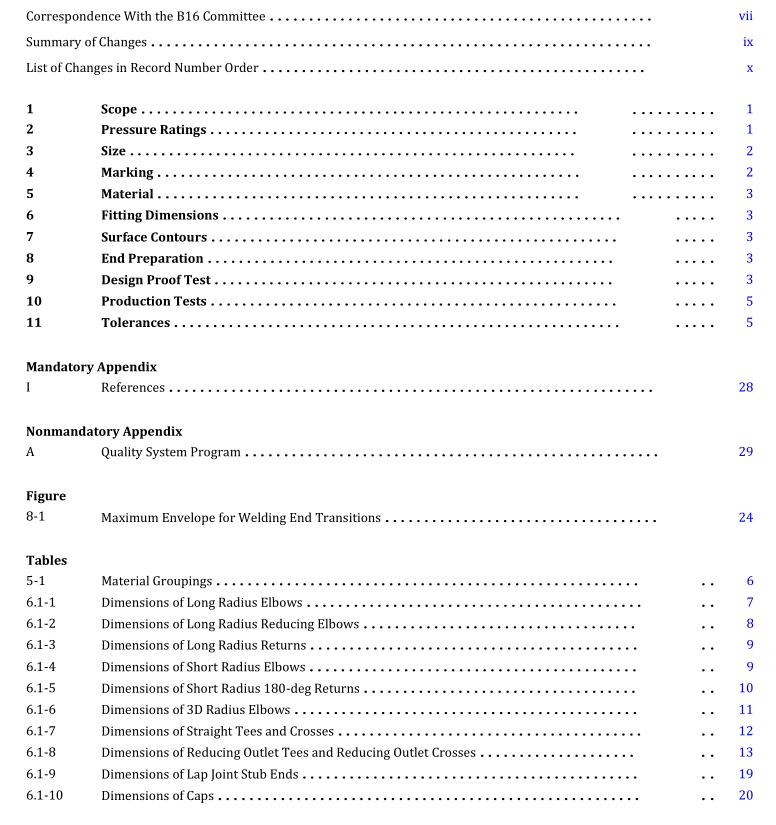ASME B16.9 pdf download

ASME B16.9 pdf download Factory-Made Wrought Buttwelding Fittings
1 SCOPE1.1 General
This Standard covers overall dimensions, tolerances,ratings, testing,and markings for factory-made wrought buttwelding fittings in sizes NPS h throughNPS 48 (DN 15 through DN 1200).
1.2 Special Fittings
Fittings may be made to special dimensions, sizes,shapes,and tolerances by agreement between the man-ufacturer and the purchaser.
1.3 Fabricated Fittings
Fabricated laterals and other fittings employing circum-ferential or intersection welds are considered pipe fabri-cation and are not within the scope of this Standard.Fabricated lap joint stub ends are exempt from theabove restrictions, provided they meet all the require-ments of the applicable ASTM material specificationlisted in section 5.
1.4 Relevant Units
This Standard states values in both Sl (Metric) and u.s.Customary units. These systems of units are to be regarded separately as standard.Within the text and
tables, the U.S. Customary units are shown in parentheses.
The values stated in each system are not exact equivalents;therefore, it is required that each system of units be used independently of the other. Combining values from thetwo systems constitutes nonconformance with theStandard.
The designation for size is NPS for both Metric- andCustomary-dimensioned fittings. Fitting pressure ratingis associated with the connecting wall thickness of
pipe of equivalent size and material.
1.5 References
1.5.1 Referenced Standards. Standards and specifica-tions adopted by reference in this Standard are shown inMandatory Appendix L.lt is not considered practical toidentify the specific edition of each standard and specifi-cation in the individual references.Instead, the specificedition reference is identified in Mandatory Appendixl.A product made in conformance with a prior editionof referenced standards and in all other respects conforming to this Standard will be considered to bein conformance.
1.5.2 Codes and Regulations. A fitting used under thejurisdiction of the ASME Boiler and Pressure Vessel Code(BPVC), the ASME Code for Pressure Piping, or a govern-mental regulation is subject to any limitation of that codeor regulation. This includes any maximum temperaturelimitation or rule governing the use of a material atlow temperature.
1.6 Service Conditions
Criteria for selection of fitting types and materialssuitable for particular fluid service are not within thescope of this Standard.
1.7 Welding
Installation welding requirements are outside the scopeof this Standard.
1.8 Quality Systems
Nonmandatory requirements relating to the fittingmanufacturer’s Quality System Program are describedin Nonmandatory Appendix A.
1.9 Convention
For determining conformance with this Standard, theconvention for fixing significant digits where limits(maximum and minimum values) are specified shall beas defined in ASTM E29.This requires that an observedor calculated value be rounded off to the nearest unit in thelast right-hand digit used for expressing the limit. Decimalvalues and tolerances do not imply a particular method ofmeasurement.
1.10 Pressure Rating Designation
Class followed by a dimensionless number is the des-ignation for pressure-temperature ratings. Standardizeddesignations for flanges per ASME B16.5 referenced in thisStandard are Classes 150,300,600,900,1500, and 2500.2 PRESSURE RATINGS
2.1 Basis of Ratings
2 PRESSURE RATINGS 2.1 Basis of Ratings The allowable pressure ratings for fittings designed in accordance with this Standard may be calculated as for straight seamless pipe of equivalent material (as shown by comparison of composition and mechanical properties in the respective material specifications) in accordance with the rules established in the applicable sections of ASME B31, Code for Pressure Piping. For the calculation, applicable data for the pipe size, wall thickness,and material that are equivalent to that of thefitting shall be used. Pipe size, wall thickness (or schedulenumber), and material identity on the fittings are in lieu ofpressure rating markings.
2.2 Design of Fittings
2.2.1 Acceptable Design Methods. The design offittings shall be established by one of the following
methods:
(a) mathematical analyses contained in nationallyrecognized pressure vessel or piping codes (e.g.,ASMEB31.3 para.304.2 for elbows and para.304.3 for tees).(b) proof testing in accordance with section 9 of thisStandard.
(c) experimental stress analysis, such as described inASME BPVC, Section VIII, Division 2,Annex 5.F with vali-dation of results. Hydrostatic testing can be used to vali-date experimental results.
d) detailed stress analysis (e.g.,finite element method)with results evaluated as described in ASME BPVC. SectionVII,Division 2,Part 5 with validation of results. Strainmeasurement, photoelastic testing, or hydrostatictesting can be used to validate calculated results.
2.2.2 Design Thickness. To meet design or manufac-turing requirements, it is expected that some portion offormed fittings may have to be thicker than the pipe wallwith which the fitting is intended to be used.The math-ematical analyses, if used , may take into account suchthicker sections.
2.2.3 Records.Copies of English-language records ofthe mathematical analysis, the successful proof test, orboth shall be made available to the purchaser or regula-tory authority upon request.
3 SIZE
NPS, followed by a dimensionless number, is the des-ignation for nominal fitting size. NPS is related to the refer-ence nominal diameter, DN, used in international
standards.The relationship is. typically, as follows:









